Jabiru Stork
- December 17, 2023
- 0 comment
The Jabiru Stork(Jabiru mycteria) is a member of the stork family Ciconiidae. These large birds are characterized by their distinctive black neck and head, contrasting with a white plumage on the rest of their body. The species is native to the Americas and is primarily found in Central and South America, inhabiting various wetland environments. The Jabiru Stork is renowned for its impressive size, with a tall stature, long legs, and a wingspan that contributes to its remarkable presence in its natural habitat.
Physical Appearance
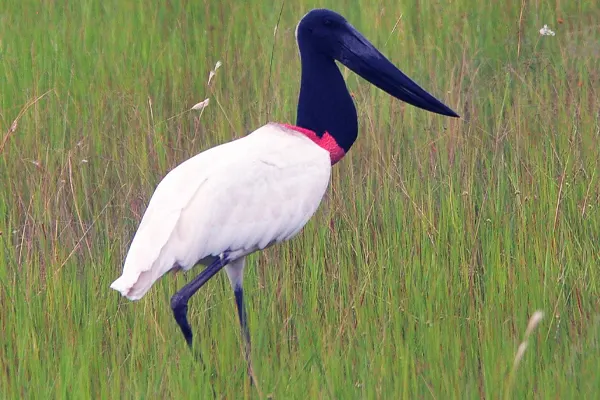
Jabiru Stork
- Lifespan: 25 years
- Habitat: Wetlands, Marshes, Floodplains.
- Diet: Amphibians, Reptiles, Small Mammals, and Invertebrates.
- Size: 130 to 150 cm
- Weight: 8 to 14 pounds
- Wingspan: 7 to 9 feet
- Conservation Status: Least Concern
- Population Trend: Population Stable
These storks play a crucial role in the ecosystem as apex predators, maintaining the balance of aquatic populations through their diverse diet, which includes fish, amphibians, reptiles, small mammals, and invertebrates.
Species Type of Jabiru Stork
The name “Jabiru” is sometimes used for other stork species like the Black-necked stork (Ephippiorhynchus asiaticus) and the Saddle-billed stork (Ephippiorhynchus senegalensis), these are distinct species and not classified as Jabiru mycteria.
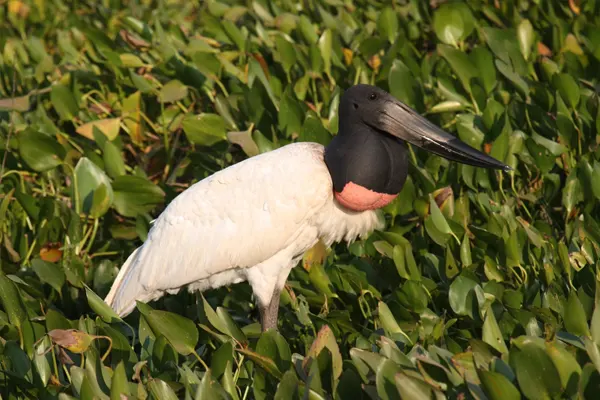

Jabiru mycteria, commonly known as the Jabiru Stork, is a fascinating species of large bird belonging to the stork family Ciconiidae. Native to the Americas, these majestic birds are predominantly found in the wetlands, marshes, and floodplains of Central and South America. One of the distinguishing features of the Jabiru Stork is its striking black neck and head, contrasting vividly with its white plumage elsewhere on the body.
Feather Coloration of Jabiru Stork
The overwhelming majority of the Jabiru’s plumage is pure white, covering its entire body, wings, and tail. This white coloration provides excellent camouflage against the bright skies and reflective waters of its wetland habitat.

Male
- Head and Neck: The Jabiru has a hairless, black head and neck, which creates a striking contrast with its white plumage. This black coloration extends to the bird’s beak, which can be up to 30 cm (12 inches) long.
- Wingtips: The tips of the Jabiru’s primary and secondary wing feathers are black, forming a distinct black band across the wingspan. This black band is visible both in flight and when the bird is at rest.
- Legs and Feet: The Jabiru’s legs and feet are also black, adding another contrasting element to its overall appearance.
Female
- Mohawk: The Jabiru has a small, white crest on its head, resembling a mohawk. This crest is more pronounced in males and may be used in courtship displays.
- Neck Pouch: Both male and female Jabiru storks have a red, featherless pouch at the base of their necks. This pouch is more prominent and vibrant in males, especially during the breeding season.

The Jabiru Stork’s feather coloration is characterized by its predominant white plumage with contrasting black markings on the head, neck, wingtips, legs, and feet. This combination of colors creates a striking and easily identifiable appearance for this large and majestic bird.
Flight Characteristics of Jabiru Stork
These flight characteristics allow the Jabiru to excel in its wetland habitat, searching for prey and navigating through its vast territory with remarkable ease and grace.
Flight Style
- The Jabiru typically exhibits a slow and steady flapping flight, with a wingbeat frequency of around two flaps per second. This deliberate flight style allows it to conserve energy while covering long distances.
- When soaring, the Jabiru takes advantage of thermal updrafts, rising high into the air without flapping its wings. This ability to soar allows it to cover vast distances without expending significant energy.

Maneuverability
- Despite its large size, the Jabiru is surprisingly agile and maneuverable, capable of making sharp turns and dives with relative ease. This maneuverability is essential for catching prey and navigating through dense vegetation.
- The Jabiru’s long, powerful legs also play a role in its flight, acting as rudders during turns and providing balance while landing.
Despite their impressive flight capabilities, Jabiru Storks are also known for spending a significant amount of time on the ground, wading in shallow waters in search of food. Their flight characteristics are well-adapted to their ecological role, allowing them to cover expansive wetland areas efficiently and access different feeding and nesting sites.
Migration Patterns of Jabiru Stork
Jabiru Storks exhibit varying migration patterns depending on the local conditions and availability of resources. While some populations of Jabiru Storks are considered sedentary, meaning they stay in the same area year-round, others may engage in seasonal movements.
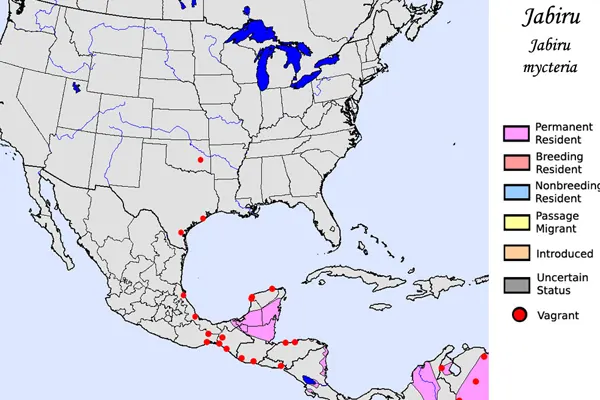
In regions where water availability and food sources are subject to significant seasonal changes, Jabiru Storks may undertake migratory journeys in search of more favorable conditions. Their migrations are often influenced by the need to find suitable breeding and feeding grounds.
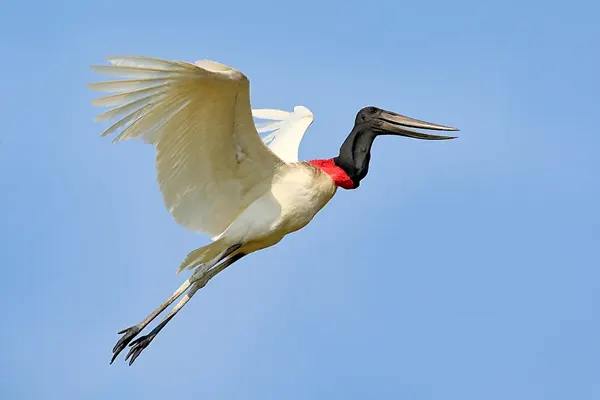
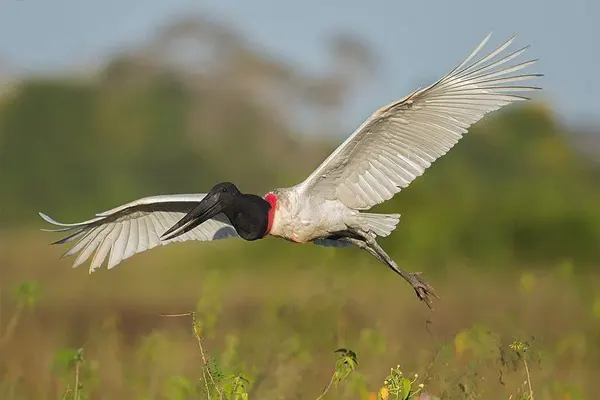
During migration, Jabiru Storks can cover considerable distances, utilizing their impressive wingspan and soaring flight patterns. They may form V-shaped formations, which help reduce wind resistance and conserve energy during these long journeys. Thermal updrafts and air currents are often utilized by these storks to facilitate their flights.
It’s important to note that the specific migration patterns of Jabiru Storks can vary among populations. Some individuals or groups may move between wetland areas in response to seasonal changes in water levels and food availability, while others may remain in a relatively fixed location throughout the year.
Habitat & Distribution of Jabiru Stork
Jabiru Storks are primarily inhabitants of wetland ecosystems, favoring habitats such as marshes, swamps, flooded plains, and riverbanks. They show a preference for areas with shallow water, which provides an abundant supply of fish and other aquatic prey. These storks are also known to inhabit freshwater lakes and ponds, as well as seasonally flooded grasslands. Their nesting sites are typically located in trees or on elevated structures in close proximity to water sources.
- Shallow water: They use their long beaks to probe for food in shallow water, so they require habitats with water depths typically less than 1 meter.
- Abundant prey: They need areas with ample fish, amphibians, reptiles, small mammals, birds, crustaceans, and insects to sustain their diet.
- Open areas: They prefer open spaces for foraging and hunting, as well as tall trees for nesting.
- Minimal disturbance: They are sensitive to human disturbance and prefer undisturbed wetlands for breeding and raising young.
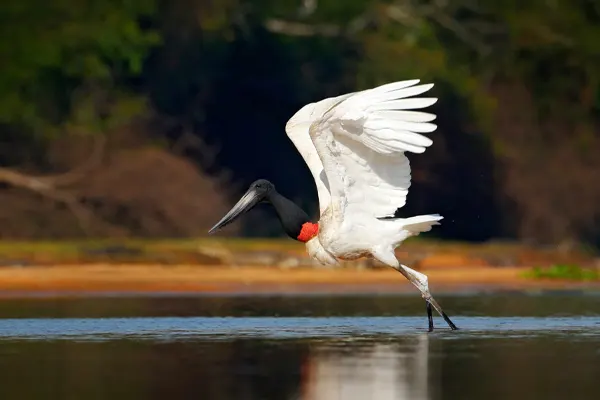
- Distribution: Jabiru Storks are native to the Americas, with their range extending through parts of Central and South America. They can be found in countries such as Mexico, Belize, Guatemala, Honduras, Nicaragua, Costa Rica, Panama, Colombia, Venezuela, Ecuador, Peru, Bolivia, Brazil, Paraguay, and northern Argentina.
The distribution of Jabiru Storks is not uniform, and their presence in specific regions can be influenced by factors such as habitat availability, food resources, and breeding conditions. While some populations are resident and remain in the same area throughout the year, others may undertake seasonal migrations in response to changing environmental conditions.
Behavioral Traits of Jabiru Stork
These unique behavioral traits have allowed the Jabiru Stork to thrive in its wetland habitat for centuries. Understanding these behaviors is important for conservation efforts, as it helps us to identify threats to their populations and develop strategies to protect them. By protecting their habitat and ensuring their continued survival, we can help to ensure that this majestic bird can continue to grace the skies of the Americas for generations to come.
- Solitary feeders: Jabiru storks are typically solitary feeders, hunting and foraging on their own. They use their vision and long beaks to probe shallow water and mudflats for prey, including fish, amphibians, reptiles, small mammals, birds, crustaceans, and insects.
- Patient stalkers: They are patient hunters, often standing very still and waiting for prey to come within striking distance before launching a rapid attack.
- Opportunistic feeders: They are not picky eaters and will take advantage of any opportunity to find food. They have been known to follow other birds, such as herons, to steal their prey.

- Colonial breeders: Jabiru storks breed in colonies that can range in size from a few pairs to several hundred pairs. Colonies are typically located in tall trees near water, where they build large platform nests from sticks and branches.
- Monogamous relationships: Jabiru storks form monogamous pairs that stay together for life. They share the responsibility of incubating eggs and raising young.
- Long breeding season: The breeding season varies depending on the location, but generally lasts from March to October. Females typically lay 2-4 eggs, which both parents incubate for about 30 days.
- Cooperative parenting: Both parents care for the young chicks, feeding them regurgitated food and protecting them from predators. Chicks fledge after about 70-80 days.
Role in Ecosystem of Jabiru Stork
The Jabiru Stork is crucial not only for the well-being of this iconic species but also for the broader health of the ecosystems it inhabits. Efforts to protect wetlands and manage these environments sustainably are essential for ensuring the continued presence of Jabiru Storks and the biodiversity they support.
- Population control: By preying on fish, amphibians, reptiles, small mammals, and other animals, Jabiru storks help to regulate the populations of these prey species and maintain the balance of the ecosystem.
- Disease control: Jabiru storks are known to eat dead fish and carrion, which helps to prevent the spread of disease and improve the quality of water in isolated bodies of water after droughts or fish die-offs.
- Cleaning up the environment: By consuming dead animals and other organic matter, Jabiru storks help to clean up the environment and prevent the accumulation of waste.
- Nutrient cycling: Through their feeding and defecation, Jabiru storks contribute to the cycling of nutrients within the ecosystem.

- Impact on prey populations: Jabiru storks can have a significant impact on the populations of their preferred prey, such as small fish and amphibians. However, this predation is generally considered to be beneficial, as it helps to keep prey populations in check and prevents them from overgrazing on resources.
- Relationship with other species: Jabiru storks sometimes compete with other birds, such as herons and egrets, for food and nesting sites. They may also be preyed upon by large birds of prey, such as eagles and hawks.
- Economic importance: The Jabiru Stork is an important part of the ecotourism industry in many parts of its range. Tourists come from all over the world to see these magnificent birds in their natural habitat.
The important role that the Jabiru Stork plays in the ecosystem, we can better appreciate its value and take steps to protect it. Through conservation efforts, we can ensure that this remarkable bird continues to thrive in its wetland home for generations to come.
Dietary Habits of Jabiru Stork
The Jabiru Stork’s feeding behavior is characterized by a patient and stealthy approach. When hunting, the stork often stands quietly in water, minimizing disturbances to avoid alarming potential prey. Its adaptability to various prey types highlights its role as an apex predator in wetland ecosystems. The diverse diet of the Jabiru Stork contributes to the ecological balance of its habitat, influencing the populations of different species within the food web.
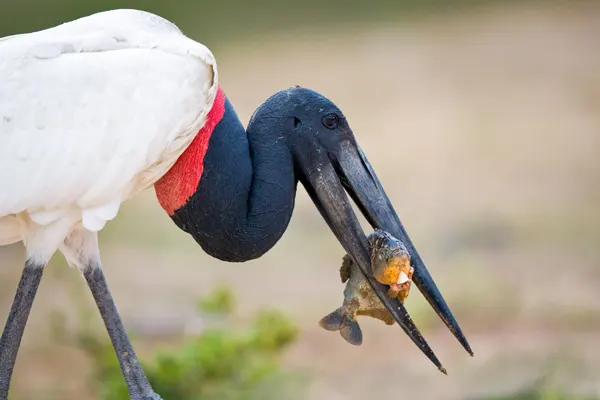
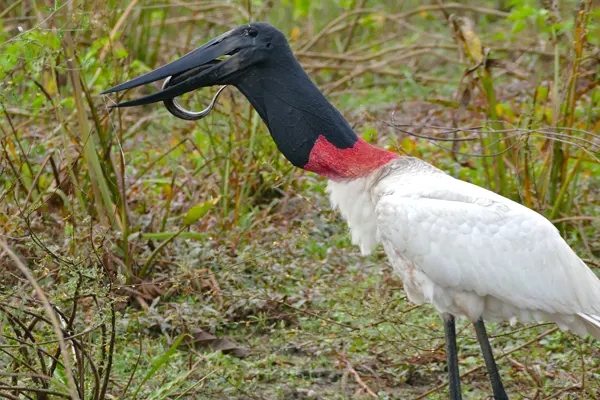
- Fish: Fish make up a significant portion of the Jabiru Stork’s diet. They are skilled hunters, using their long legs and sharp, pointed bills to catch fish in shallow waters. The stork often stands motionless, waiting for a suitable opportunity to strike and catch its prey.
- Amphibians: Jabiru Storks also consume amphibians, such as frogs and toads. They use their precise beaks to snatch amphibians from the water or surrounding vegetation.
- Reptiles: Reptiles, including snakes and small reptiles, form part of the Jabiru Stork’s diet. Their hunting technique is adaptable, allowing them to capture a variety of reptilian prey.
- Small Mammals: The storks are known to feed on small mammals, such as rodents. They may forage on land or in shallow water to locate and capture these terrestrial prey items.
- Invertebrates: Invertebrates, including insects and crustaceans, are supplementary components of the Jabiru Stork’s diet. They may capture these small creatures in or around the water.
Interesting Facts of Jabiru Stork
These interesting facts, we can appreciate the Jabiru Stork’s fascinating world and take steps to protect this ecological marvel. Their remarkable adaptations and vital role in the ecosystem make the Jabiru Stork a truly special bird worthy of our admiration and protection.
- Tallest Flying Bird in the Americas: Standing up to 1.4 meters (4.6 feet) tall with a wingspan of up to 2.8 meters (9.2 feet), the Jabiru Stork holds the title of the tallest flying bird in Central and South America.
- Unique Beak: The Jabiru Stork boasts a long, powerful beak that can reach up to 30 cm (12 inches) in length. This specialized beak is perfectly adapted for spearing fish and other prey in shallow water.
- Opportunistic Feeder: While their primary diet consists of fish, amphibians, and reptiles, Jabiru Storks are not picky eaters. They are known to opportunistically feed on small mammals, birds, crustaceans, insects, and even carrion.
- Communication Through Feather Displays: Jabiru Storks use a variety of feather displays to communicate with each other and attract mates. These displays include raising their wings, fluffing their feathers, and spreading their tails.
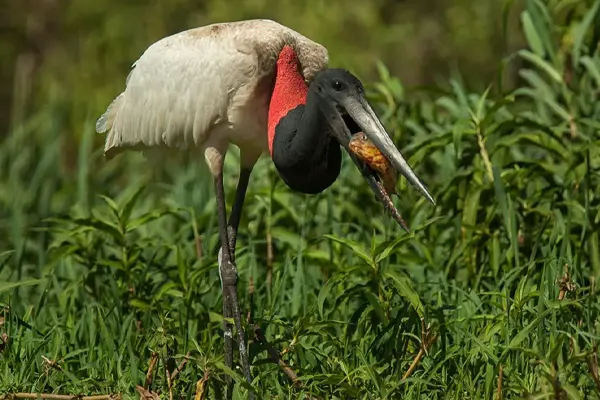
- Rain Dancing: A fascinating behavior observed in Jabiru Storks is their rain dance. This ritualistic dance involves flapping their wings and jumping up and down while facing the rain. The purpose of this dance is not fully understood, but it may be a way of greeting the rain or communicating with other members of their flock.
- Communal Nesting: While they may form colonies during the breeding season, Jabiru Storks often exhibit communal nesting behavior, with several nests constructed in close proximity to one another.
Nesting Habits of Jabiru Stork
The nesting habits of Jabiru Storks is crucial for their conservation, as it provides insights into their reproductive biology and the factors influencing the success of their breeding efforts. Protecting suitable nesting habitats and minimizing disturbances during the breeding season are important considerations for their overall well-being.
- Nesting Sites: Jabiru Storks build large and conspicuous nests, often located in trees or on elevated structures. They may choose trees with sturdy branches, emergent vegetation, or man-made structures such as power poles or dead trees. The selection of these sites is crucial for protecting the nests from potential predators.
- Nest Construction: Both male and female Jabiru Storks participate in the construction of the nest. They use sticks and other plant materials to build a platform-like structure. The nest can grow quite large over time as the storks continuously add new materials.
- Colonial Nesting: While they are not strictly colonial nesters, Jabiru Storks may form loose nesting colonies during the breeding season. In these colonies, several pairs of storks may build their nests in close proximity to one another.
- Parental Roles: Both parents take part in incubating the eggs and caring for the chicks after hatching. The incubation period is typically around 32 to 34 days. During this time, the parents share responsibilities, taking turns to keep the eggs warm and protected.
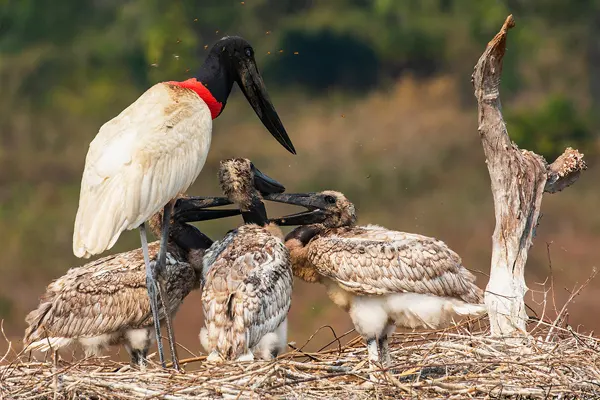
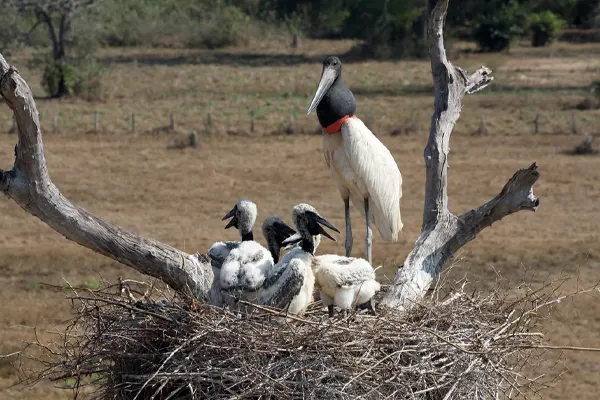
- Number of Eggs: Jabiru Storks generally lay a small clutch of eggs, often numbering two or three. The number of eggs may vary based on factors such as environmental conditions and the availability of food resources.
- Chick Development: Once the chicks hatch, they are initially covered with white down. The parents continue to care for and feed the chicks until they are capable of fledging and leaving the nest, which usually occurs after several weeks.
- Territorial Defense: While not highly territorial, Jabiru Storks may defend their nesting sites during the breeding season. This behavior helps protect the nest and chicks from potential threats.
The unique nesting habits of the Jabiru Stork and the challenges they face, we can develop effective conservation strategies to protect this magnificent bird and ensure its continued survival for future generations.
Calls & Vocalizations of Jabiru Stork
Jabiru Storks are generally known for their rather quiet nature compared to other stork species, but they do produce a range of vocalizations for communication. These vocalizations play a role in various social situations, including interactions between mates and parents and offspring.
- Grunts and Croaks: Jabiru Storks often emit grunting and croaking sounds, which are used for communication within the colony, particularly during the breeding season. These vocalizations may serve to establish territory, attract mates, or communicate with nearby individuals.
- Bill Clattering: Jabiru Storks engage in bill clattering, a behavior where they rapidly snap their bills together, creating a distinctive sound. Bill clattering is observed during courtship displays and may also be used as a form of communication between mates or family members.

- Hissing: When threatened or disturbed, Jabiru Storks may produce a hissing sound. This vocalization is often a defensive response, signaling discomfort or a desire to deter potential threats.
- Silence: While generally not highly vocal, Jabiru Storks can remain silent for extended periods. This silence is often observed during their patient hunting behavior, where they stand motionless in shallow waters, waiting for prey to approach.
The vocal repertoire of Jabiru Storks may vary based on individual behavior, social context, and specific circumstances. While their calls may not be as extensive or loud as some other bird species, these vocalizations still play a crucial role in their communication within the colony and in various social interactions.
Conservation Status of Jabiru Stork
The Jabiru Stork’s “Least Concern” status indicates that, overall, the population is considered stable, and the species is not currently at significant risk of extinction. However, localized threats, such as habitat loss, changes in water availability, and potential human disturbances, can impact specific populations.
- Habitat loss: Conversion of wetlands for agriculture, development, and infrastructure projects is the biggest threat to Jabiru Stork habitat.
- Habitat degradation: Pollution from agricultural runoff and industrial waste can harm the fish and other prey that Jabiru Storks depend on.
- Hunting: Jabiru Storks are sometimes hunted for their meat and feathers.
- Climate change: Changes in rainfall patterns and rising sea levels can alter water levels and vegetation in wetlands, negatively affecting Jabiru Storks.

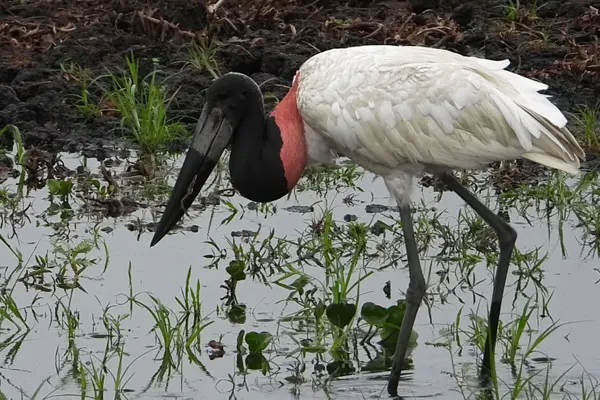
The future of the Jabiru Stork depends on our continued efforts to protect its habitat, mitigate threats, and raise awareness about its importance. By addressing these challenges, we can ensure that this magnificent bird continues to grace the skies of the Americas for generations to come.
Research and Ongoing Studies of Jabiru Stork
- Population Dynamics: Researchers may be studying the population dynamics of Jabiru Storks, including their distribution, abundance, and trends over time. This information is crucial for understanding the overall health of the species.
- Habitat Use and Selection: Studies could be investigating the specific habitats preferred by Jabiru Storks, as well as their nesting site selection criteria. This research helps identify critical areas for conservation and management.
- Breeding Biology: Researchers may be examining the breeding biology of Jabiru Storks, including their reproductive success, nesting behaviors, and factors influencing chick survival. Understanding their reproductive biology contributes to effective conservation strategies.
- Migration Patterns: For populations that migrate, researchers may be tracking the migration patterns of Jabiru Storks, identifying key stopover sites and understanding the factors influencing their migratory behavior.
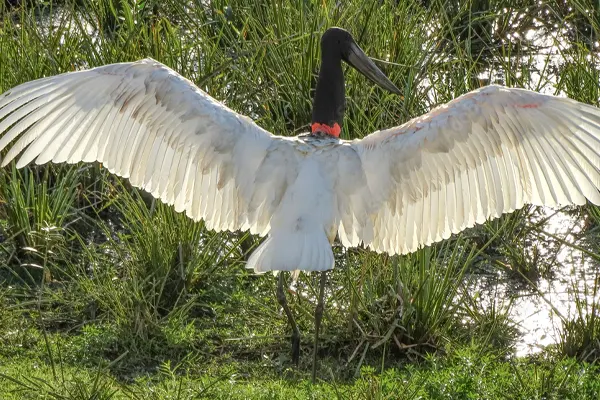
- Threats and Conservation: Studies may be assessing the various threats faced by Jabiru Storks, such as habitat loss, pollution, and human disturbances. Conservation initiatives often involve identifying and mitigating these threats to ensure the species’ long-term survival.
- Climate Change Impact: Research may be exploring the potential impact of climate change on Jabiru Stork habitats, migration patterns, and food availability. Understanding these impacts can aid in developing adaptive management strategies.
- Community Involvement: Some studies may involve working with local communities to understand human-wildlife interactions, promote awareness, and involve communities in conservation efforts to ensure the coexistence of Jabiru Storks and local human populations.
Educational and Ecotourism of Jabiru Stork
The educational and ecotourism potential of the Jabiru Stork, we can raise awareness about wetland conservation, inspire environmental stewardship, and contribute to the long-term survival of this magnificent bird. Engaging communities, promoting responsible tourism practices, and integrating education into ecotourism activities are crucial for ensuring a sustainable future for both the Jabiru Stork and its vital wetland habitat.
- Raising awareness: The Jabiru Stork can serve as a flagship species for raising awareness about wetland conservation and the importance of protecting these vital ecosystems.
- Inspiring environmental education: Its unique adaptations, behavior, and ecological role can be used to develop engaging educational programs for students of all ages.
- Promoting appreciation for wildlife: Observing and learning about the Jabiru Stork can foster appreciation for nature and the incredible diversity of life on Earth.
- Enhancing scientific understanding: Research on the Jabiru Stork contributes to our understanding of bird biology, ecology, and the impacts of human activities on wildlife.
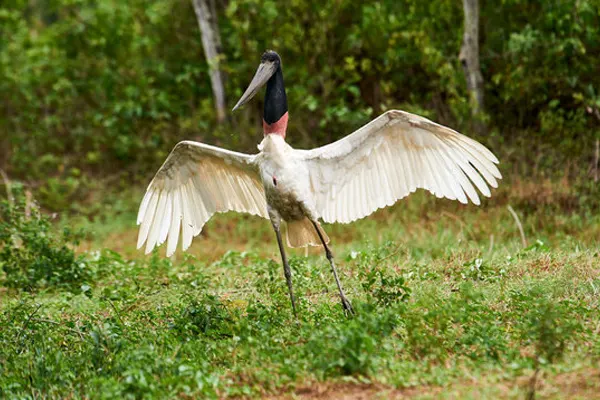
Ecotourism Potential
- Attracting tourists: The Jabiru Stork is a major draw for birdwatchers and nature enthusiasts seeking unique wildlife experiences.
- Promoting sustainable tourism: Ecotourism focused on the Jabiru Stork can generate income for local communities, encouraging conservation efforts and responsible tourism practices.
- Supporting conservation initiatives: Ecotourism revenue can be used to fund research, habitat protection, and community conservation projects.
- Educating tourists: Ecotourism activities can be designed to educate visitors about the Jabiru Stork, its habitat, and the importance of conservation.
Educational and ecotourism initiatives related to the Jabiru Stork can play a crucial role in raising awareness about these magnificent birds and promoting conservation efforts.
Conclusion
The Jabiru Stork is a fascinating and majestic bird that plays a vital role in the health of wetland ecosystems. Its impressive size, unique adaptations, and fascinating behavior make it a captivating creature worthy of our admiration and protection.
Through understanding its habitat needs, dietary habits, breeding behavior, fascinating calls, and current conservation status, we can appreciate its ecological significance and contribute to its continued survival. Research and ongoing studies continue to provide valuable insights into the Jabiru Stork’s life and the challenges it faces. Additionally, its educational and ecotourism potential offers opportunities to raise awareness, inspire environmental stewardship, and support conservation initiatives.


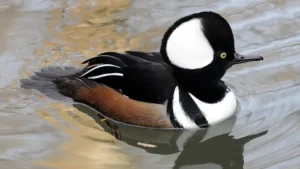
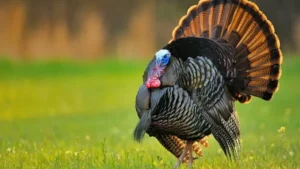


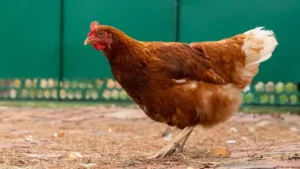

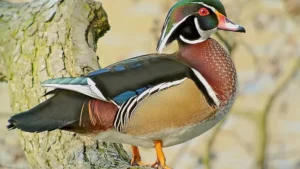
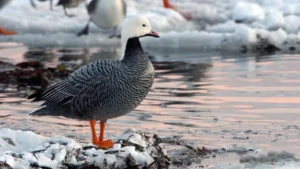
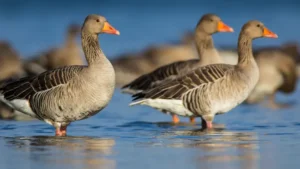
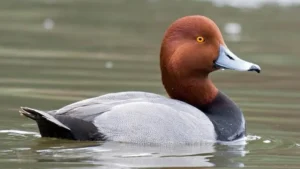

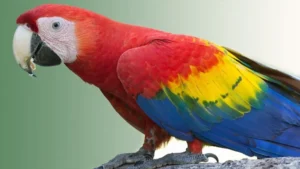
Leave your comment